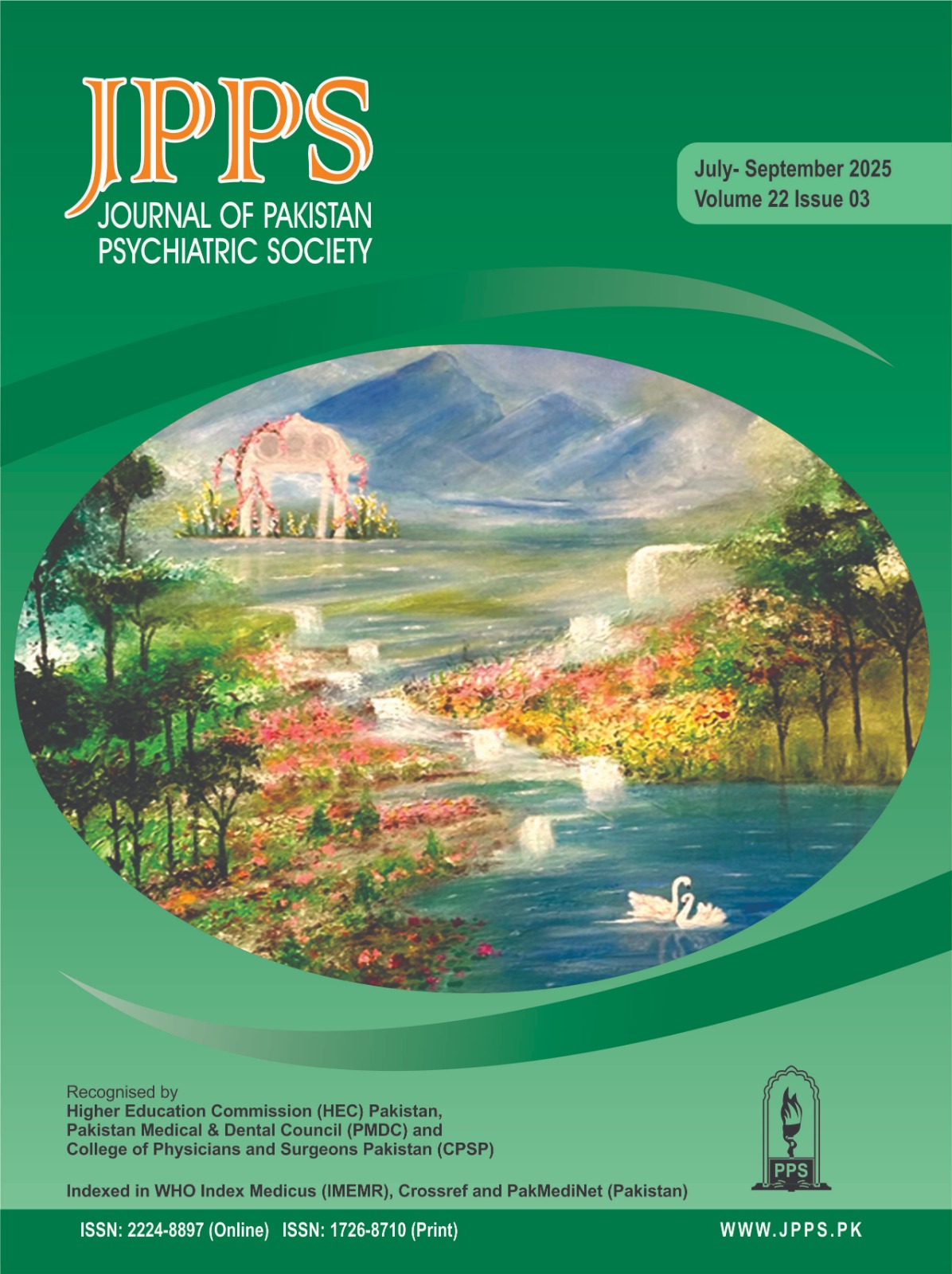Association of Perceived Parenting Styles with General Family Functioning in Young Adults with Borderline Personality Disorder
Abstract
ABSTRACT
OBJECTIVES
Current study focused on the predictive association of perceived parenting styles (i.e., permissive, authoritative, & authoritarian) with general family functioning (i.e., problem solving, communication, roles, affective responsiveness, affective involvement and behavior control). in young adults with borderline personality disorders.
HYPOTHESIS
Considering the literature it was hypothesized that the perceived parenting styles (mothers & fathers) would predict the dysfunctional pattern of general family functioning in young adults with borderline personality disorders.
METHOD AND SAMPLE
A cross-sectional study design, using a sample of 51 participants diagnosed with borderline personality disorder ages between18-25 years (M = 22.55, SD = 1.629). Among them 16 (31.4%) were male and 35 (68.6%) were female. Participants were recruited from different out-patient setups in Karachi. Instruments used in this study were, Socio-demographic Information Form, Parental Authority Questionnaire (PAQ) and The McMaster Family Assessment Device (FAD). .
RESULTS
The findings of the study highlighted that coefficient of the multiple regression analysis found that perceived permissive style of mothers and fathers (β= .122, t= .751 p> 0.05 and β, -.171 t, -.789 p> 0.05) does not significantly predicts the general family functioning, while perceived authoritative parenting of both parents (β,=-.400, t= -2.537, p< 0.05and β, -.417 t, -2.312 p< 0.05) significantly predict general family functioning of participants of study. Moreover, perceived authoritarian parenting styles of mothers (β= .387, t= 2.342 p< 0.05) have a significant effect on general family functioning, while authoritarian approach of fathers (β, .051 t, .270 p> 0.05) does not affect the general family functioning of young adults with borderline personality disorder.
CONCLUSION
Further limitations of the study and future implications were discussed.
Downloads
References
2 Minuchin, S., & Fishman, H. C. (1981). Family therapy techniques. Harvard University Press.
3 Angley, M., Divney, A., Magriples, U., & Kershaw, T. (2015). Social support, family
functioning, and parenting competence in adolescent parents. Maternal and Child Health Journal, 19(1), 67–73. https://doi.org/10.1007/s10995-014-1496-x
4 Matejevic, M., Jovanovic, D., & Lazarevicb, V. (2014). Functionality of family relationships and parenting style in families of adolescents with substance abuse problems. Procedia - Social and Behavioral Sciences, 128, 281–287. https://doi.org/10.1016/j.sbspro.2014.03.157
5 Masten, A. S., & Shaffer, A. (2006). How Families Matter in Child Development: Reflections
from Research on Risk and Resilience. In A. Clarke-Stewart & J. Dunn (Eds.), Families count: Effects on child and adolescent development (pp. 5–25). Cambridge University Press. https://doi.org/10.1017/CBO9780511616259.002
6 Gilgoff, R., Singh, L., Koita, K., Gentile, B., & Marques, S. S. (2020). Adverse childhood experiences, outcomes, and interventions. Pediatric Clinics of North America, 67(2), 259–273.
7 Pilkington, P. D., Bishop, A., & Younan, R. (2020). Adverse childhood experiences and early
maladaptive schemas in adulthood: A systematic review and meta-analysis. Clinical Psychology & Psychotherapy, 28(3), 569–584. https://doi.org/10.1002/cpp.2533
8 Howenstein, J., Kumar, A., Casamassimo, P. S., McTigue, D., Coury, D., & Yin, H. (2015). Correlating parenting styles with child behavior and caries. Pediatric Dentistry, 37(1), 59–64.
9 Baumrind, D. (1971). Current patterns of parental authority. Developmental Psychology,
4(1, Pt. 2), 1–103. https://doi.org/10.1037/h0030372
10 Ryan, C. E., Epstein, N. B., & Keitner, G. I. (2005). Evaluating and treating families: The
McMaster approach. Taylor & Francis.
11 Epstein, N. B., Bishop, D. S., & Levin, S. (1978). The McMaster model of family functioning. Journal of Marital and Family Therapy, 4(4), 19–31. https://doi.org/10.1111/j.1752-0606.1978.tb00537.x
12 Miller, I. W., Ryan, C. E., Keitner, G. I., Bishop, D. S., & Epstein, N. B. (2000). The McMaster approach to families: Theory, assessment, treatment, and research. Journal of Family Therapy, 22(2), 168–189. https://doi.org/10.1111/1467-6427.00145
13 Fitzpatrick, M. A. (2004). Communication and family functioning: Advances in communication theory. Journal of Family Communication, 4(3), 171–178. https://doi.org/10.1080/15267431.2004.9670134
14 Hughes, A. E., Crowell, S. E., Uyeji, L., & Coan, J. A. (2012). A developmental neuroscience of borderline pathology: Emotion dysregulation and social baseline theory. Journal of Abnormal Child Psychology, 40(1), 21–33. https://doi.org/10.1007/s10802-011-9533-0
15 Skodol, A. (2019). Borderline personality disorder: Epidemiology, pathogenesis, clinical
features, course, assessment, and diagnosis. UpToDate. https://www.uptodate.com/contents/borderline-personality-disorder-epidemiology-pathogenesis-clinical-features-course-assessment-and-diagnosis
16 Mainali, P., Rai, T., & Rutkofsky, I. H. (2020). From child abuse to developing borderline
personality disorder into adulthood: Exploring the neuromorphological and epigenetic pathway. Cureus, 12(7), e9474. https://doi.org/10.7759/cureus.9474
17 Yen, S., Shea, M. T., Battle, C. L., Johnson, D. M., Zlotnick, C., Dolan-Sewell, R., Skodol, A.
E., Grilo, C. M., Gunderson, J. G., Sanislow, C. A., Zanarini, M. C., Bender, D. S., Rettew, J. B., & McGlashan, T. H. (2002). Traumatic exposure and posttraumatic stress disorder in borderline, schizotypal, avoidant, and obsessive-compulsive personality disorders: Findings from the collaborative longitudinal personality disorders study. Journal of Nervous and Mental Disease, 190(8), 510-518. https://doi.org/10.1097/00005053-200208000-00003
18 Fonagy, P., & Luyten, P. (2009). A developmental, mentalization-based approach to the
understanding and treatment of borderline personality disorder. Development and Psychopathology, 21(4), 1355–1381. https://doi.org/10.1017/S0954579409990198
19 Nelson, D. A., Swanson, S. M., Coyne, S. M., Hart, C. H., & Olsen, J. A. (2014). Parenting,
relational aggression, and borderline personality features: Associations over time in a Russian longitudinal sample. Development and Psychopathology, 26(3), 773–787. https://doi.org/10.1017/S0954579414000445
20 Schuppert, H. M., Albers, C. J., Minderaa, R. B., Emmelkamp, P. M., & Nauta, M. H. (2012).
Parental rearing and psychopathology in mothers of adolescents with and without borderline personality symptoms. Child and Adolescent Psychiatry and Mental Health, 6(1), 29. https://doi.org/10.1186/1753-2000-6-29
22 Steele, K. R., Townsend, M. L., & Grenyer, B. (2019). Parenting and personality disorder: An overview and meta-synthesis of systematic reviews. PLOS ONE, 14(10), e0223038. https://doi.org/10.1371/journal.pone.0223038
23 American Psychiatric Association. (2013). Diagnostic and statistical manual of mental disorders (5th ed.). Arlington, VA: American Psychiatric Publishing. https://doi.org/10.1176/appi.books.9780890425596
24 Buri, J. R. (1991). Parental authority questionnaire. Journal of Personality Assessment, 57(1), 110–119. https://doi.org/10.1207/s15327752jpa5701_13
25 Epstein, N. B., Baldwin, L. M., & Bishop, D. S. (1983). The McMaster Family Assessment Device. Journal of Marital and Family Therapy, 9(2), 171–180.
26 Byles, J., Byrne, C., Boyle, M. H., & Offord, D. R. (1988). Ontario child health study: Reliability and validity of the general functioning subscale of the McMaster Family Assessment Device. Family Process, 27(1), 97–104. https://doi.org/10.1111/j.1545-5300.1988.00097.x
27 Lyons-Ruth, K., Choi-Kain, L., Pechtel, P., Bertha, E., & Gunderson, J. (2011). Perceived parental protection and cortisol responses among young females with borderline personality disorder and controls. Psychiatry Research, 189(3), 426–432. https://doi.org/10.1016/j.psychres.2011.07.038
28 Okorodudu, G. N. (2010). Influence of parenting styles on adolescent delinquency in Delta Central Senatorial District. Edo Journal of Counseling, 3(1), 58–86. https://doi.org/10.4314/ejc.v3i1.52682
29 Pearson, A. L. (2013). The impact of parenting styles on the emotional regulation of adolescents. Master of Social Work Clinical Research Papers, (248). http://sophia.stkate.edu/msw_papers/248
30 Sanvictores, T., & Mendez, M. D. (2022). Types of parenting styles and effects on children. StatPearls. StatPearls Publishing. https://www.ncbi.nlm.nih.gov/books/NBK482492
31 Gfroerer, K., Kern, R., & Curlette, W. (2004). Research support for individual psychology’s
parenting model. Journal of Individual Psychology, 61, 379–388.
32 Keshavarz, S., & Baharudin, R. (2009). Parenting style in a collectivist culture of Malaysia.
European Journal of Social Sciences, 10(1), 66–73.
33 Kagitcibasi, C. (1996). Family and human development across cultures: A view from the other side (1st ed.). Psychology Press. https://doi.org/10.4324/9781315805993
34 Darling, N., & Sternberg, L. (1993). Parenting style as context: An integrative model. Psychological Bulletin, 113, 487–496.
35 Markus, H. R., & Kitayama, S. (1991). Culture and the self: Implications for cognition, emotion, and motivation. Psychological Review, 98(2), 224–253. https://doi.org/10.1037/0033-295X.98.2.224
Copyright (c) 2025 Journal of Pakistan Psychiatric Society

This work is licensed under a Creative Commons Attribution-NonCommercial 4.0 International License.
Copyright © JPPS. Published by Pakistan Psychiatric Society
Licensing: This work is licensed under Creative Commons Attribution-NonCommercial 4.0 International License
Readers may “Share-copy and redistribute the material in any medium or format” and “Adapt-remix, transform, and build upon the material”. The readers must give appropriate credit to the source of the material and indicate if changes were made to the material. Readers may not use the material for commercial purposes. The readers may not apply legal terms or technological measures that legally restrict others from doing anything the license permits.






.png)









